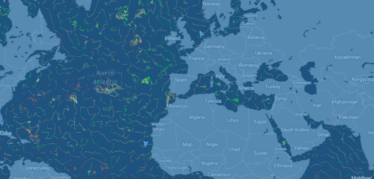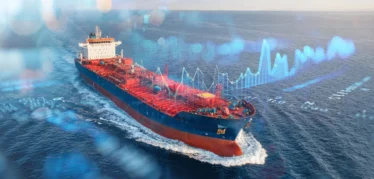Freight transactions are becoming more complex than ever, requiring stakeholders to balance myriad variables to arrive at an optimal outcome.
Monumental initiatives like decarbonization have only added to the complexity of decision-making dynamics. There has been an emerging call for heightened visibility into the trade. Achieving this level of visibility in a standardized and scalable way requires a fundamental change in the way the maritime world makes decisions, a bold step forward into the future of smarter decisions.
Now that digitalization has taken hold within the industry, it has paved the way for this new era of possibility for maritime. It is now possible to bring relevant data together at the point of decision making with unprecedented accuracy and context. But to do so, organizations require a strong foundation of digital technology that can bring together the key elements of informed decision making into one, comprehensive ecosystem.
We do a deep dive into this topic in our new The Fundamentals of Making Smarter Freight Decisions Guide. Check it out!
In this blog, we will touch on some important concepts covered in the guide, including how to apply three key elements of smarter decision making to navigate some of the most significant challenges facing the entire maritime industry.
What Makes Smarter Decision Making Possible?
For maritime shipping organizations in today’s digital age, informed decisions lie at the intersection of different kinds of pertinent data—market insights, business requirements, and current contractual positions. Understanding and utilizing these diverse data points to improve decision making requires three key elements to be present.
The Three Elements of Smarter Decision Making
1. Right Data, Right Place, Right Time
During all phases of the freight transaction, stakeholders need to bring together key data from the market at large, from the business and its requirements, and from current market positions. When combined in a connected workflow, these data can be surfaced at the right place and time to bring context and inform smarter, more informed decisions.
In today’s world, a connected workflow is only possible if digital tools and systems are talking to each other and allow for collaboration within the organization. Additionally, structured and secure integrations with external parties can add enriching insights from outside the organization to the decision-making process. It is also important to note that not all workflows are the same, and it is important to ensure that the connected workflow that underpins the business is tightly aligned with its unique degree of scale and complexity.
2. Standardized Connectivity
As the industry continues to become more open to sharing information that was once held close to the vest, the need for further definition of standards that support strategic and flexible sharing continues to grow. This requires scalable analysis within and between systems, partners, and counterparties by defining standards and built for purpose data exchange protocol.
Some of the core tenets of success for standardized connectivity include flexible integrations, the ability to capture the full spectrum of required data, scalability, and the emergence of industry-wide standards that work for all.
3. Actionable Market Intelligence
Differentiated market intelligence has the potential to position industry participants on an uneven playing field. Industry participants who have access to and properly leverage their own data and the data that is available in the market will create a competitive advantage for their company.
This third and final pillar of maritime decision-making relates to how the maritime shipping industry considers and adapts to the world around it to enhance its commercial advantage. There are four critical success factors for market intelligence, which include high integrity data, access to a broad and deep range of market data, access to data in real-time, and data delivery that is utility driven and user friendly.
A convergence of these three key pillars at the point of decision making is powerful because it enables the business to harness the most meaningful data at the most relevant moment and with the greatest possible agility.
Now let’s look at how to apply these tenets to some of the most crucial decisions facing maritime shipping.
Decision 1: Differentiating pre-fixture decisions against competitors.
Between 2020 and 2021, the global commercial shipping fleet grew by just 5%, resulting in a delta between global freight supply and global freight demand. For commercial maritime shipping organizations, this delta between supply and demand presents enormous opportunity for those who are strategic and data-driven in their approach to identifying the most profitable deals. Mapping a smarter way to optimal decisions requires a heavy amount of data-driven pre-fixture insights from within the organization, supported by external market intelligence, and then married with a concise view of available options for the trade.
Decision 2: Minimizing emissions throughout the voyage lifecycle.
From the vessel to the intended route, port congestion, weather patterns, and more, there are numerous factors that impact emissions. Pressure to decarbonize maritime trade from regulatory bodies and industry consortiums across the supply chain continues to build. This pressure has led to a transformative uptick in decarbonization-focused innovation within the maritime shipping ecosystem. Organizations that have embraced digital innovation and data to make more sustainable decisions have already made strides in reducing their carbon footprint. Making smarter decisions for a decarbonized future requires data-driven decision support and sharing of emissions data, backed by market intelligence to standardize insights.
For more on making sustainable freight decisions, watch this on-demand webinar or read the recap.
Decision 3: Maximizing operational efficiency while ensuring compliance.
Operational efficiency is top of mind for successful maritime shipping businesses. The definition of efficiency will vary as workflows and business needs change. Decisions made day to day can have a large impact on the business, especially as rates or costs across the business increase. Global shortage and other factors have prompted a rise in voyage-related costs, including the costs of labor, bunkers, port fees and more. High costs result in outsized supply chain expenses for those who are purchasing marine freight.
All of this increases the financial significance of every operational decision, as well as the potential negative impact of any inefficiency that makes its way into the workflow. Helping to ensure operational efficiency means not letting anything slip through the cracks, which is why it’s so important to have checks and balances set up throughout the commercial workflow and allow for process controls that are tailored to the business’s unique requirements. Ensuring all required checks occur in the most expeditious manner is an evolving pursuit within the industry as new data sources that provide perspective on ownership and vessel status from a safety and sanctions vantage point emerge.
Decision 4: Sharpening strategies to outperform the market.
The maritime shipping ecosystem generates a massive amount of data, which has been estimated at some-120 million data points per day. But data does not equal insight, and insight does not equal understanding. To translate this data into competitive advantage, maritime shipping organizations must bring together all three decision making elements in a data flow that is contextual, standardized, and market aware. Securing competitive advantage at a macro level requires holistic historical data that is continuously captured and integrated, an open approach to integration, and a strong support of real-time market intelligence.
The right commercial platform must enable powerful decision support, drive standardization within an organization, and provide differentiated market intelligence with high levels of integrity, security, and context. At Veson, our vision is to be the standard platform that propels maritime commerce by bringing the three elements of smarter decision making to life in the workflows of real maritime shipping organizations on all sides of the marine contract.
To read more, access our free guide: The Fundamentals of Making Smarter Freight Decisions.



 Aidan Williams
Aidan Williams
 Antoine Grisay
Antoine Grisay
 Josh Luby
Josh Luby